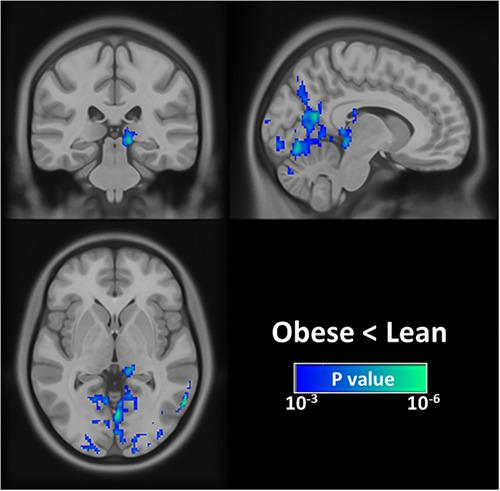当前位置:
X-MOL 学术
›
NMR Biomed.
›
论文详情
Our official English website, www.x-mol.net, welcomes your
feedback! (Note: you will need to create a separate account there.)
The influence of obesity on cerebral blood flow in young adults using arterial spin labeling MRI.
NMR in Biomedicine ( IF 2.7 ) Pub Date : 2020-07-29 , DOI: 10.1002/nbm.4375 Shin-Lei Peng,Chun-Ming Chen
NMR in Biomedicine ( IF 2.7 ) Pub Date : 2020-07-29 , DOI: 10.1002/nbm.4375 Shin-Lei Peng,Chun-Ming Chen

|
Obesity causes damage to several organs, including the brain. Recent studies have been focusing on understanding the mechanisms through which obesity affects brain structure and function using neuroimaging techniques. A functional biomarker, such as cerebral blood flow (CBF), is a powerful tool that can be used to explore neural dysfunction. However, there is currently limited information regarding the association between CBF and obesity. The study was conducted to investigate the potential effect of obesity on brain perfusion in a young cohort aged 20‐30 years. A total of 21 obese (body mass index (BMI) > 26 kg/m2) and 21 lean (BMI < 24 kg/m2) right‐handed volunteers were included in this study. CBF was acquired using the 2D single post‐labeling delay (PLD) arterial spin labeling (ASL) technique on a 3 T MRI scanner. A multiple regression analysis was performed to examine the difference in global and regional gray matter (GM) CBF between the groups. CBF value was assigned as the dependent variable, whereas age, sex, and group (obese or lean) were considered as the independent variables. Results showed that group‐related differences in CBF were homogeneous across brain regions, as obese subjects had significantly lower global GM CBF than lean subjects (P < 0.05). In the voxelwise analysis, obese individuals had significantly lower CBF in the left pulvinar of the thalamus and visual association areas, including Brodmann area (BA) 7, BA18, and BA19, than lean subjects. Although the signal‐to‐noise ratio was slightly compromised for 2D sequences and subject‐specific arterial transit time was not estimated due to a single PLD sequence, this study demonstrated alterations in CBF in obese subjects, particularly in regions of the pulvinar of the thalamus and its synchronously related areas such as visual association areas. These results suggest that ASL provides a potential platform for further obesity‐related research.
中文翻译:

使用动脉自旋标记 MRI 研究肥胖对年轻人脑血流的影响。
肥胖会对包括大脑在内的多个器官造成损害。最近的研究一直专注于使用神经成像技术了解肥胖影响大脑结构和功能的机制。功能性生物标志物,例如脑血流量 (CBF),是一种强大的工具,可用于探索神经功能障碍。然而,目前关于 CBF 与肥胖之间关联的信息有限。该研究旨在调查肥胖对 20-30 岁年轻人群脑灌注的潜在影响。共有 21 名肥胖(体重指数 (BMI) > 26 kg/m 2)和 21 名瘦人(BMI < 24 kg/m 2) 右手志愿者包括在这项研究中。在 3 T MRI 扫描仪上使用 2D 单标记后延迟 (PLD) 动脉自旋标记 (ASL) 技术获取 CBF。进行多元回归分析以检查各组之间全局和区域灰质 (GM) CBF 的差异。CBF 值被指定为因变量,而年龄、性别和组(肥胖或瘦)被认为是自变量。结果表明,CBF 的组相关差异在整个大脑区域是同质的,因为肥胖受试者的整体 GM CBF 显着低于瘦受试者(P< 0.05)。在体素分析中,与瘦人相比,肥胖者在丘脑左叶丘和视觉关联区(包括布罗德曼区 (BA) 7、BA18 和 BA19)的 CBF 显着降低。尽管 2D 序列的信噪比略有下降,并且由于单个 PLD 序列没有估计受试者特定的动脉通过时间,但该研究表明肥胖受试者的 CBF 发生了变化,尤其是在丘脑叶丘区域及其同步相关的区域,如视觉关联区域。这些结果表明 ASL 为进一步的肥胖相关研究提供了一个潜在的平台。
更新日期:2020-09-03
中文翻译:

使用动脉自旋标记 MRI 研究肥胖对年轻人脑血流的影响。
肥胖会对包括大脑在内的多个器官造成损害。最近的研究一直专注于使用神经成像技术了解肥胖影响大脑结构和功能的机制。功能性生物标志物,例如脑血流量 (CBF),是一种强大的工具,可用于探索神经功能障碍。然而,目前关于 CBF 与肥胖之间关联的信息有限。该研究旨在调查肥胖对 20-30 岁年轻人群脑灌注的潜在影响。共有 21 名肥胖(体重指数 (BMI) > 26 kg/m 2)和 21 名瘦人(BMI < 24 kg/m 2) 右手志愿者包括在这项研究中。在 3 T MRI 扫描仪上使用 2D 单标记后延迟 (PLD) 动脉自旋标记 (ASL) 技术获取 CBF。进行多元回归分析以检查各组之间全局和区域灰质 (GM) CBF 的差异。CBF 值被指定为因变量,而年龄、性别和组(肥胖或瘦)被认为是自变量。结果表明,CBF 的组相关差异在整个大脑区域是同质的,因为肥胖受试者的整体 GM CBF 显着低于瘦受试者(P< 0.05)。在体素分析中,与瘦人相比,肥胖者在丘脑左叶丘和视觉关联区(包括布罗德曼区 (BA) 7、BA18 和 BA19)的 CBF 显着降低。尽管 2D 序列的信噪比略有下降,并且由于单个 PLD 序列没有估计受试者特定的动脉通过时间,但该研究表明肥胖受试者的 CBF 发生了变化,尤其是在丘脑叶丘区域及其同步相关的区域,如视觉关联区域。这些结果表明 ASL 为进一步的肥胖相关研究提供了一个潜在的平台。











































 京公网安备 11010802027423号
京公网安备 11010802027423号